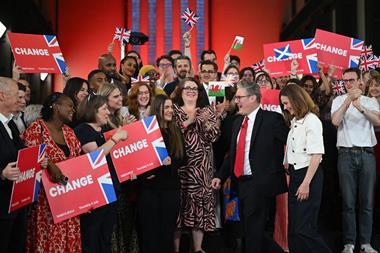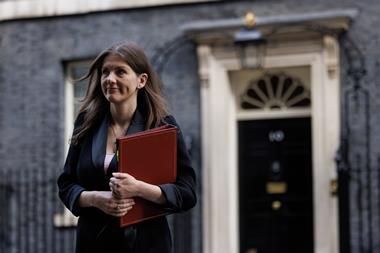With the polls predicting a Labour win, if not an outright landslide, Chemistry World has looked at the three major UK parties’ plans for research, innovation and education. The Conservatives offer business as usual, while Labour favours long-term budgets for key research organisations but doesn’t address the uncertainties facing higher education funding. The Liberal Democrats is the only party to stress the importance of rebuilding links with Europe.

R&D and innovation
The Conservatives have promised to increase public spending on R&D by 10% a year to £22 billion in the next parliament. They committed in the March 2020 budget to increase it to £22 billion per year by 2024–25, but this was later changed to 2026–27. Apart from that, it stresses stability by continuing with its science and technology framework published in 2023 and its work with UKRI.
The Labour manifesto doesn’t provide any definite spending targets for R&D. It will introduce 10-year budgets for key R&D institutions but declined to say which. However, Chi Onwurah, shadow science, research and innovation minister, has said the UKRI will be one. While acknowledging that it’s not possible to bind any future parliaments, she said a 10-year budget is feasible as demonstrated by the UK’s Aerospace Technology Institute, which has managed to attract significant private sector investment.
The Liberal Democrats have pledged to invest at least 3% of GDP in R&D by 2030, rising to 3.5% by 2034. They stress the importance of strengthening links to Europe by continuing to participate in Horizon Europe, joining the European Innovation Council and rejoining the Erasmus+ programme as an associated country.
The Liberal Democrats have also pledged to develop an industrial strategy and re-establish the Industrial Strategy Council. The Conservatives will maintain R&D tax relief and improve access to finance for small- and medium-sized companies (SMEs). While Labour said it wants a stable tax regime for investors, it doesn’t mention R&D tax credits specifically. However, it promised better support for start-ups and university spinout companies. It would establish a new Regulatory Innovation Office to speed up approvals and promised to modify national planning policy to make it easier to build laboratories, digital infrastructure and gigafactories.
Nick Hillman, director of the Higher Education Policy Institute, says both the Conservatives and Labour commitments seem weak compared with other recent elections. In 2019, the Conservatives promised ‘the fastest ever increase in domestic public R&D spending’ while Labour committed to an R&D target of 3% of GDP by 2030. ‘Now it feels like the research community are being offered (a little) more money or a 10-year plan whereas both are needed simultaneously if the grand challenges facing the UK – like sluggish growth, climate change and stalled life expectancy – are to start being fully addressed.’
Kieron Flanagan, a science policy expert at the University of Manchester, expects Labour to stick with the present government’s plan to raise R&D to £20 billion per year and then on to £22 billion if circumstances allow. ‘My guess is the lack of commitment in terms of figures is just a reflection of their broader “Ming vase strategy” of not making any slip-ups. In terms of the manifesto, it’s very vague. But almost all political manifestos say very little about science and research. As I have always said, an actual 10-year budget is just not possible in our system – so this will basically be a 10-year spending plan rather than a fixed commitment. We’ve had those before, and they are not always honoured, but, still, it’s a good thing to have.’
Labour will be asking some hard questions about value when it comes to research funding, says Neil Lee, an economic geographer at the London School of Economics. ‘Labour has very clear missions and any spending which doesn’t contribute to those missions will be questioned. This might mean money going from resource-rich places to other areas. For example, if Oxbridge is getting a huge amount of research money and this is just contributing to land prices in these towns, the government will be rightly wondering if the money could be better spent in big cities such as Manchester or Leeds.’
However, the Campaign for Science and Engineering (CaSE) welcomed Labour’s long-term plan for R&D, which it said will give the research community and the private sector confidence to invest. CaSE is also pleased to see the Conservatives maintain R&D tax relief ‘given the recent successive policy changes which has led to a lack of clarity and certainty for businesses’. CaSE members have said that R&D tax credits have been crucial in encouraging R&D investment by UK businesses.
Education
The Conservative manifesto doesn’t contain any plans to address the financial pressures facing universities. However, it committed to close courses in England with poor outcomes for their students. The universities regulator, the Office for Students, will prevent universities from recruiting students to courses with high drop-out rates or which leave students worse off than if they hadn’t gone to university. The manifesto also includes a pledge for new teachers in key STEM and technical subjects to receive bonuses of up to £30,000 tax-free over five years.
Labour said they will reform post-16 education and improve the integration of further and higher education. While its manifesto noted the economic pressures facing universities and criticised the current higher education funding settlement, it doesn’t elaborate on how it would ‘create a secure future for higher education’. But it said it will support the aspiration of every person who wants to go to university.
The Liberal Democrats, by contrast, committed to a review of higher education finance. The party also pledged to support teacher training, recruitment and retention in schools. Other commitments included ensuring every secondary school child is taught by a specialist subject teacher and establishing a cross-party commission to review curriculum and current qualifications.
The election manifestos of Labour and the Conservatives ignored the two biggest issues facing higher education institutions and students in England, says Hillman. Neither party has offered to reduce the shortfall in the cost of teaching students from the UK by raising tuition fees or increasing grants to universities, or improving student maintenance support.
Perhaps the strangest thing about the Conservative’s manifesto is the change in direction, he says. ‘After 14 years of expansionary policies, we are told courses and places should be cut. This implies the most successful education policy of recent years – the big increase in the proportion of young people making it to higher education – was wrong. The anti-university rhetoric of the Conservative manifesto is odd because the people displaced as a result of the closure of university degree programmes are meant to end up in high-level apprenticeships instead. Yet in 2022–23, under 4000 18-year-olds began a degree-level apprenticeship.’
Labour seems to be offering more stability when it comes to higher education policy, he adds. ‘Even though they leave the funding questions open, it is a welcome shift.’
Immigration
The Conservatives would continue with its current immigration policy, including blocking international students bringing dependants into the country and increasing the salary threshold for skilled worker visas by 48% to £38,700. The changes brought in by the Conservatives are likely to have direct consequences on recruiting international talent into research roles, according to CaSE. It favours an immigration and visa system that does not act as a barrier to attracting the most talented researchers to the UK.
Labour said it would reform the points-based system and reduce net migration. The Liberal Democrats pledged to replace the current salary threshold with a more flexible merit-based system for work visas. It would also report international student flows separately to estimates of long-term migration.
‘I think it’s clear that [Labour] will want to be very careful around the politics of immigration but, in principle, will be supportive of high-skilled immigration where there are obvious gaps/needs, and research would seem to be a prime example of that,’ Flanagan says.












No comments yet